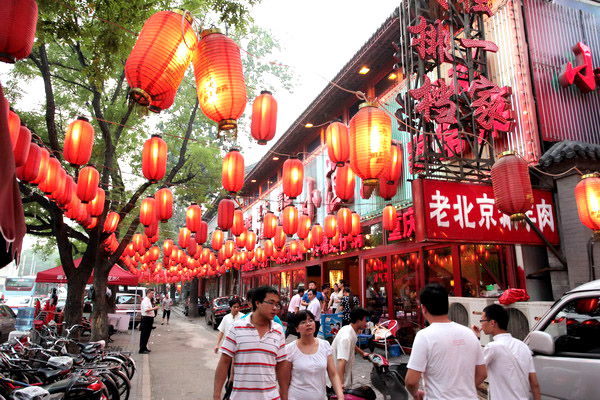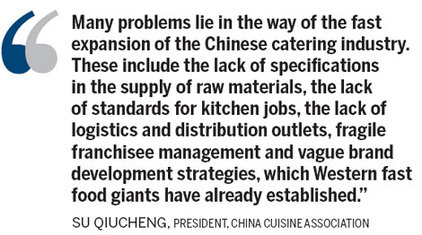Chinese restaurant chains face challenges
Updated: 2012-09-17 09:25
By Li Woke (China Daily)
|
||||||||
The need for quality control makes the recipe for expansion very problematic
For a Chinese restaurant, expanding across the country or even outside the country can be much harder than starting from zero.
"I have five Chinese restaurants in Beijing but I am finding it very difficult to expand further because making sure every dish at every restaurant is exactly the same is problematic," said Liu Tao, general manager of a Yunnan cuisine restaurant in Beijing.
|
 Pedestrains on Guijie Street, the well-known food street in downtown Beijing with many Chinese restaurants side by side. One effective way to expand and develop Chinese restaurants is to learn from the experience of Western restaurant chains and to standardize the whole cooking process, said Su Qiucheng, president of the China Cuisine Association. [Photo/China Daily] |
Take the famous General Tso's chicken or kung pao chicken as an example. Cooks have to mix the chicken, salt and egg white before heating the wok. Then dozens of seasonings are added to enrich the flavor, such as pepper, garlic, soy sauce, cooking wine, monosodium glutamate, vinegar, starch, sesame oil, Chinese onions and peanuts.
The dish will taste very different if the cooks add fewer or more seasonings or if it is cooked at a different temperature.
"In Chinese cuisine, one dish can taste totally different if it is made by different chefs," said Jia Guolong, board chairman of Xibei Restaurant.
Another Chinese fast food chain, Xinshang Fast Food in Qingdao, also struggled to satisfy customers while expanding locally. "Ensuring customers at each store have the same quality fast food is a major task," said Zhang Hongji, board chairman of the chain.
"Many problems lie in the way of the fast expansion of the Chinese catering industry," said Su Qiucheng, president of the China Cuisine Association. "These include the lack of specifications in the supply of raw materials, the lack of standards for kitchen jobs, the lack of logistics and distribution outlets, fragile franchisee management and vague brand development strategies, which Western fast food giants have already established."
Jia said one effective way to expand and develop Chinese restaurants is to learn from the experience of Western restaurant chains and to standardize the whole cooking process.
|
|
Zhang said Xinshang learnt a lot from the success of the United States fast food giant McDonald's Corp by strictly controlling the food's standardization, including the preparation of raw materials.
McDonald's, the world largest fast food chain, now has more than 33,000 outlets in 119 countries across the world. They have their secrets to make sure every burger in every restaurant is of the same quality, whether it's in a small Chinese city or a big United States metropolis.
"McDonald's burgers are made from 100 percent whole cuts of beef from British and Irish farms, with nothing added apart from a pinch of salt and pepper after cooking. The meat is then minced, shaped and frozen to make McDonald's beef patties. All beef is checked for bone and gristle to ensure that none finds its way into patties," said Joy Clachan, agricultural assurance manager at McDonald's UK.
After checking, the beef will be minced and frozen. Then the patties are hand-packed into boxes and a final quality check takes place before they are dispatched.
Inside a McDonald's restaurant, a burger will be fully cooked after being heated for more than 37 seconds. The buns are toasted and the meal is finished off by adding onion and pickle, said the company.
Chen Jie, kitchen assistant general manager of Jindingxuan, a famous Guangdong-style restaurant in Beijing, said: "standardizing our cooking procedure can improve the efficiency of professional chefs as well as cutting down costs. Our customers will be happy because they will spend less time waiting at their table."
McDonald's not only standardizes kitchen work but also its food resources. They can trace beef back to the farms where it was produced so the company knows exactly how the animal was reared.
Industry experts said traceability benefits the company's food management system. It is also essential because it ensures customer confidence in the company's food safety arrangements.
"Each Chinese restaurant operator should fully understand the importance of transforming and upgrading the industry," said vice-minister of Commerce Jiang Zengwei. "(They) should learn from the experience of foreign counterparts to improve their own conditions, including the processing and distribution of food."
Xibei Restaurant's Jia said he will push forward the standardization of Xibei before opening about 30 restaurants next year in first tier cities in China, such as Beijing, Shanghai and Guangzhou.
"The future of the Chinese food chain industry will be prosperous," said Su Qiucheng, president of the China Cuisine Association. "Look at Haidilao Hot Pot, XE Flavor and the Quanjude (Group) Co: They have all shown momentum in the rapid and sound development of their Chinese restaurant chains over the past years."
Last year, revenues of the Chinese catering industry topped 2 trillion yuan ($315 billion). The figure is expected to reach 3.7 trillion yuan by the end of 2015, according to the Ministry of Commerce.
liwoke@chinadaily.com.cn

 Relief reaches isolated village
Relief reaches isolated village
 Rainfall poses new threats to quake-hit region
Rainfall poses new threats to quake-hit region
 Funerals begin for Boston bombing victims
Funerals begin for Boston bombing victims
 Quake takeaway from China's Air Force
Quake takeaway from China's Air Force
 Obama celebrates young inventors at science fair
Obama celebrates young inventors at science fair
 Earth Day marked around the world
Earth Day marked around the world
 Volunteer team helping students find sense of normalcy
Volunteer team helping students find sense of normalcy
 Ethnic groups quick to join rescue efforts
Ethnic groups quick to join rescue efforts
Most Viewed
Editor's Picks

|

|

|

|

|

|
Today's Top News
Health new priority for quake zone
Xi meets US top military officer
Japan's boats driven out of Diaoyu
China mulls online shopping legislation
Bird flu death toll rises to 22
Putin appoints new ambassador to China
Japanese ships blocked from Diaoyu Islands
Inspired by Guan, more Chinese pick up golf
US Weekly

|

|







